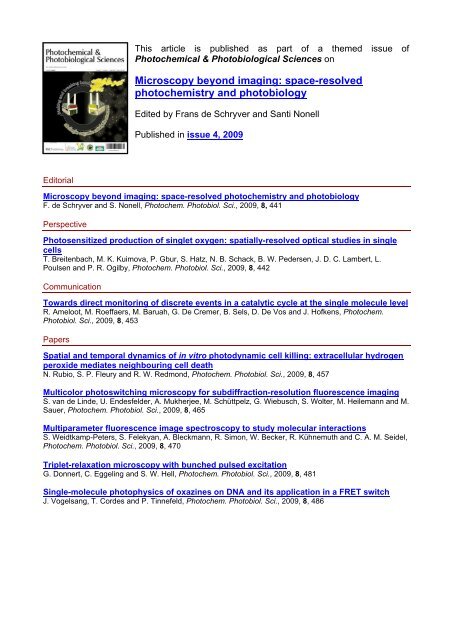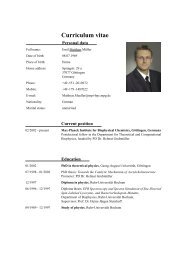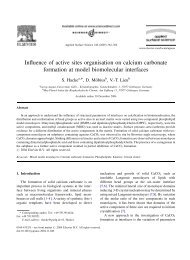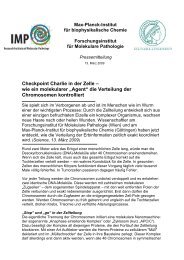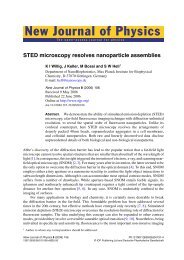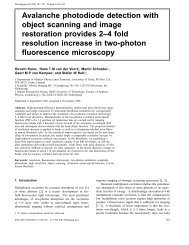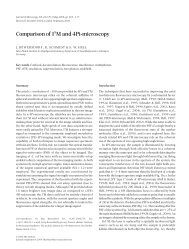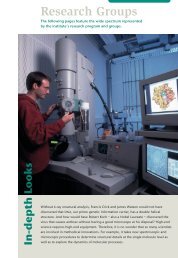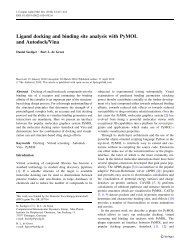Microscopy beyond imaging: space-resolved photochemistry and ...
Microscopy beyond imaging: space-resolved photochemistry and ...
Microscopy beyond imaging: space-resolved photochemistry and ...
- No tags were found...
Create successful ePaper yourself
Turn your PDF publications into a flip-book with our unique Google optimized e-Paper software.
This article is published as part of a themed issue ofPhotochemical & Photobiological Sciences on<strong>Microscopy</strong> <strong>beyond</strong> <strong>imaging</strong>: <strong>space</strong>-<strong>resolved</strong><strong>photochemistry</strong> <strong>and</strong> photobiologyEdited by Frans de Schryver <strong>and</strong> Santi NonellPublished in issue 4, 2009Editorial<strong>Microscopy</strong> <strong>beyond</strong> <strong>imaging</strong>: <strong>space</strong>-<strong>resolved</strong> <strong>photochemistry</strong> <strong>and</strong> photobiologyF. de Schryver <strong>and</strong> S. Nonell, Photochem. Photobiol. Sci., 2009, 8, 441PerspectivePhotosensitized production of singlet oxygen: spatially-<strong>resolved</strong> optical studies in singlecellsT. Breitenbach, M. K. Kuimova, P. Gbur, S. Hatz, N. B. Schack, B. W. Pedersen, J. D. C. Lambert, L.Poulsen <strong>and</strong> P. R. Ogilby, Photochem. Photobiol. Sci., 2009, 8, 442CommunicationTowards direct monitoring of discrete events in a catalytic cycle at the single molecule levelR. Ameloot, M. Roeffaers, M. Baruah, G. De Cremer, B. Sels, D. De Vos <strong>and</strong> J. Hofkens, Photochem.Photobiol. Sci., 2009, 8, 453PapersSpatial <strong>and</strong> temporal dynamics of in vitro photodynamic cell killing: extracellular hydrogenperoxide mediates neighbouring cell deathN. Rubio, S. P. Fleury <strong>and</strong> R. W. Redmond, Photochem. Photobiol. Sci., 2009, 8, 457Multicolor photoswitching microscopy for subdiffraction-resolution fluorescence <strong>imaging</strong>S. van de Linde, U. Endesfelder, A. Mukherjee, M. Schüttpelz, G. Wiebusch, S. Wolter, M. Heilemann <strong>and</strong> M.Sauer, Photochem. Photobiol. Sci., 2009, 8, 465Multiparameter fluorescence image spectroscopy to study molecular interactionsS. Weidtkamp-Peters, S. Felekyan, A. Bleckmann, R. Simon, W. Becker, R. Kühnemuth <strong>and</strong> C. A. M. Seidel,Photochem. Photobiol. Sci., 2009, 8, 470Triplet-relaxation microscopy with bunched pulsed excitationG. Donnert, C. Eggeling <strong>and</strong> S. W. Hell, Photochem. Photobiol. Sci., 2009, 8, 481Single-molecule photophysics of oxazines on DNA <strong>and</strong> its application in a FRET switchJ. Vogelsang, T. Cordes <strong>and</strong> P. Tinnefeld, Photochem. Photobiol. Sci., 2009, 8, 486
Fig. 3 Comparison of pulsed fluorescence excitation in bunches <strong>and</strong> atconstant repetition on a dye layer of Atto532. Various trains consisting ofbunches of 10 <strong>and</strong> 5 excitation pulses, arriving in time intervals of 2.5 mswere compared with a continuous 40 MHz pulse train. The timelines ofthe different pulse trains are schematically plotted in (A). The 10 <strong>and</strong>5 pulses were either applied with a repetition rate of 40 MHz with darkperiods filling up the remainder of the 2.5 ms, or evenly distributed intime with repetition rates of 4 <strong>and</strong> 2 MHz, respectively. Illumination witha total number of 5 ¥ 10 5 pulses <strong>and</strong> thus with total acquisition timesof 250 ms (5-bunch or 2 MHz) <strong>and</strong> 125 ms (10-bunch or 4 MHz)leaves differently photobleached dark spots (B) with levels of remainingfluorescence (inset B) <strong>and</strong> integrated fluorescence signal (C) depending onthe pulse intensity I p <strong>and</strong> the pulse timing of illumination. The levels ofremaining fluorescence (profile across the photobleached dye layer) <strong>and</strong>integrated fluorescence are plotted for I p = 2.9 MW cm -2 (arrow). Underthese conditions, the same number of pulses leads to the same levels ofphotobleaching <strong>and</strong> to a similar amount of integrated fluorescence signalat different I p (C), which changes upon addition of a triplet quencher(inset C), favoring excitation with a uniform repetition of pulses (circle).The lines in (C) are drawn for guidance.during illumination between the bunched <strong>and</strong> non-bunched modes(Fig. 3C).The time distance between succeeding pulses of 0.5 <strong>and</strong> 0.25 msof the continuous 2 <strong>and</strong> 4 MHz illumination mode, respectively,is smaller than the triplet lifetime of ~1 ms in the samplesinvestigated. 4 Only dark periods exceeding the average time neededfor triplet relaxation render ideal T-Rex illumination. 4 In our case,nearly ideal T-Rex illumination is attained only with interpulsetime differences of >2.5 ms, i.e. pulse repetition rates 400 kHz, i.e. to~1–2 MHz. The inset to Fig. 3C shows the fluorescence signal ofthe Atto532 layer in the presence of the triplet quencher againobtained for a total of 5 ¥ 10 5 pulses, for 5 pulses either bunchedor evenly distributed over the duty cycle of 2.5 ms. As before for the400 kHz T-Rex mode (Fig. 2), the (in this case ideal) 2 MHz T-Rexillumination is now favored over pulse bunching, resulting in about10% less signal of the bunched illumination as compared to itscontinuous counterpart. This difference can also be theoreticallyexplained for well determined kinetic parameters of rhodaminedyes, 18 specifically by a ~10-fold shorter triplet lifetime.This observation also highlights the dependence of our approachon environmental conditions. Since the lifetime of thetriplet state may change with experimental conditions such asadditives, concentration of molecular oxygen, or temperature,adjusting the timing of the experiment is required. Yet, the tripletlifetime is usually prolonged to >1 ms in biological samples orother mounting media, thus shifting the ideal T-Rex illuminationregime to repetition rates
ReferencesFig. 4 Balancing between large fluorescence signal <strong>and</strong> short acquisitiontime for fluorescence data recording applying the different modes ofexcitation: continuous (fast 40–80 MHz pulsed or CW excitation),excitation in bunches with an increasing number of pulses within a bunch<strong>and</strong> excitation with continuous low (400 kHz) repetition rate. Experimentaldata recorded for the GFP dye layer are given as black stars. CW or 40 MHzpulsed excitation realizes short acquisition times but also low levels ofsignal due to pronounced dark state populations (grey area). Excitationwith low repetition rates renders large signal levels at the expense of longacquisition times (orange area). This gap can be bridged by applyingbunched excitation (blue area) providing a good compromise betweenfluorescence signal <strong>and</strong> acquisition time.variable can be optimized for choosing the suitable excitationscheme.ConclusionOur study demonstrates that within a certain range fast scanningor bunched excitation provides an effective way of improvingthe photostability <strong>and</strong> fluorescence signal brought about by theT-Rex excitation scheme. Limiting the excitation to repetitive shortperiods of ~100–200 ns followed by breaks that are long enoughfor dark (triplet) state relaxation reduces the recording time whilestill operating close to T-Rex conditions. This observation holdstrue both for Atto532, a prominent member of the rhodaminedye family, <strong>and</strong> GFP, the archetype of fluorescent proteins. Theverification of this concept with these fluorophores indicates thegenerality of the concept. It is extendable to both CW <strong>and</strong>multi-photon excitation, as well as to STED <strong>imaging</strong>. As aresult, the bunched excitation scheme provides new degrees offreedom for balancing between signal maximization <strong>and</strong> <strong>imaging</strong>speed, thus complementing the existing modes of fluorescenceexcitation.AcknowledgementsWe acknowledge V. Westphal for helping with the electronics <strong>and</strong>S. Jakobs for providing purified GFP. We thank S. Bretschneider<strong>and</strong> A. Giske for help with the experimental setup <strong>and</strong> A. Schönlefor support with the IMSPECTOR software.1 R. Y. Tsien, Imagining <strong>imaging</strong>’s future, Nat.CellBiol., 2003, SS16–SS21.2 J. B. Pawley, (ed.), H<strong>and</strong>book of biological confocal microscopy,Springer, New York, 2nd edn., 2006.3 G. Donnert, J. Keller, R. Medda, M. A. Andrei, S. O. Rizzoli, R.Lührmann, R. Jahn, C. Eggeling <strong>and</strong> S. W. Hell, Macromolecular-scaleresolution in biological fluorescence microscopy, Proc. Natl. Acad. Sci.U. S. A., 2006, 103, 11440–11445.4 G. Donnert, C. Eggeling <strong>and</strong> S. W. Hell, Major signal increase influrorescence microscopy through dark-state relaxation, Nat. Meth.,2007, 4, 81–86.5 M. Kasha, Paths of molecular excitation, Radiat. Res., 1960, 2, 243–275.6 M. Anbar <strong>and</strong> E. Hart, The reactivity of aromatic compounds towardshydrated electrons, J. Am. Chem. Soc., 1964, 86, 5633–6537.7 E. V. Khoroshilova <strong>and</strong> D. N. Nikogosyan, Photochemistry of uridineon high intensity laser UV irradiation, J. Photochem. Photobiol. B,1990, 5, 413–427.8 C. Eggeling, J. Widengren, R. Rigler <strong>and</strong> C. A. M. Seidel, Photobleachingof fluorescent dyes under conditions used for single-moleculedetection: Evidence of two-step photolysis, Anal. Chem., 1998, 70,2651–2659.9 W. W. Webb, K. S. Wells, D. R. S<strong>and</strong>ison, <strong>and</strong> J. Strickler, Criteriafor quantitative dynamical confocal fluorescence <strong>imaging</strong>, in Optical<strong>Microscopy</strong> for Biology, ed. B. Herman, <strong>and</strong> K. Jacobson, Wiley, NewYork, 1990, pp. 73–108.10 J.-A. Conchello <strong>and</strong> J. W. Lichtman, Optical sectioning microscopy,Nat. Meth., 2005, 2, 920–931.11 R. Y. Tsien, L. Ernst, <strong>and</strong> A. Waggoner, Fluorophores for Confocal<strong>Microscopy</strong>: Photophysics <strong>and</strong> Photochemistry, in H<strong>and</strong>book of biologicalconfocal microscopy, ed. J. B. Pawley, Springer, New York, 2006,pp. 338–352.12 R. T. Borlinghaus, High Speed Scanning Has the Potential to IncreaseFluorescence Yield <strong>and</strong> to Reduce Photobleaching, Micr. Res. Tech.,2006, 69, 689–692.13 J. Fölling, M. Bossi, H. Bock, R. Medda, C. A. Wurm, B. Hein, S.Jakobs, C. Eggeling <strong>and</strong> S. W. Hell, Fluorescence nanoscopy by groundstatedepletion <strong>and</strong> single-molecule return, Nat. Meth., 2008, 5, 943–945.14 C. Eggeling, J. Widengren, R. Rigler, <strong>and</strong> C. A. M. Seidel, Photostabilitiesof fluorescent dyes for single-molecule spectroscopy: Mechanisms<strong>and</strong> experimental methods for estimating photobleaching in aqueoussolution, in Applied fluorescence in chemistry, biology <strong>and</strong> medicine, ed.W. Rettig, B. Strehmel, M. Schrader, <strong>and</strong> H. Seifert, Springer, Berlin,1999, pp. 193–240.15 J. Widengren, Ü. Mets <strong>and</strong> R. Rigler, Fluorescence correlationspectroscopy of triplet states in solution: A theoretical <strong>and</strong> experimentalstudy, J. Phys. Chem., 1995, 99, 13368–13379.16 G. H. Patterson <strong>and</strong> D. W. Piston, Photobleaching in two-photonexcitation microscopy, Biophys. J., 2000, 78, 2159–2162.17 P. S. Dittrich <strong>and</strong> P. Schwille, Photobleaching <strong>and</strong> stabilization offluorophores used for single-molecule analysis with one- <strong>and</strong> twophotonexcitation, Appl. Phys. B, 2001, 73, 829–837.18 C. Eggeling, A. Volkmer <strong>and</strong> C. A. M. Seidel, Molecular PhotobleachingKinetics of Rhodamine 6G by One- <strong>and</strong> Two-Photon InducedConfocal Fluorescence <strong>Microscopy</strong>, ChemPhysChem, 2005, 6, 791–804.19 J. Widengren, A. Chmyrov, C. Eggeling, P.-A. Löfdahl <strong>and</strong> C. A. M.Seidel, Strategies to Improve Photostabilities in Ultrasensitive FluorescenceSpectroscopy, J. Phys. Chem. A, 2007, 111, 429–444.20 I. Gregor, D. Patra <strong>and</strong> J. Enderlein, Optical Saturation in FluorescenceCorrelation Spectroscopy under Continuous-Wave <strong>and</strong> PulsedExcitation, ChemPhysChem, 2004, 5, 1–7.This journal is © The Royal Society of Chemistry <strong>and</strong> Owner Societies 2009 Photochem. Photobiol. Sci., 2009, 8, 481–485 | 485


